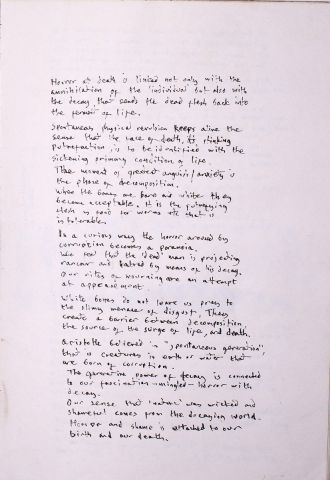(Bataille. L’Erotisme, 1957)
Horror at death is linked not only with the annihilation of the ‘individual’ but also with the decay that sends the dead flesh back into the ferment of life.
Spontaneous physical revulsion keeps alive the sense that the face of death, its stinking putrefaction, is to be identified with the sickening primary condition of life. The moment of greatest anguish/anxiety is the phase of decomposition. When the bones are bare and white they become acceptable. It is the putrefying flesh as food for worms etc that is intolerable.
In a curious way the horror aroused by corruption becomes paranoia. We feel that the ‘dead’ man is projecting rancour and hatred by means of his decay. Our rites of mourning are an attempt at appeasement.
White bones do not leave us prey to the slimy menace of disgust. They create a barrier between decomposition, the source of the surge of life, and death.
Aristotle believed in “spontaneous generation”. That is creatures in earth or water that are born of corruption. The generative power of decay is connected to our fascination-mingled horror with decay.
Our sense that ‘nature’ was wicked and shameful comes from the decaying world. Horror and shame is attached to our birth and death.









